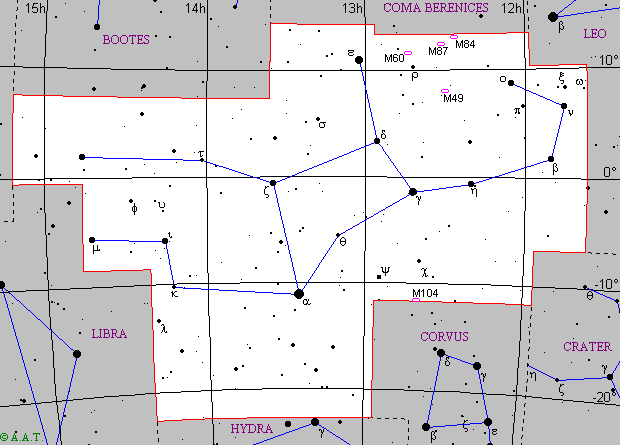 |
 |
| English name | Virgin | ||||
|---|---|---|---|---|---|
| Major stars | alpha Virginis | Spica | magn. 1,0 | RA: 13h 25m 11.61s | Dec: -11° 09' 40.6" |
| gamma Virginis | Porrima | magn. 2,9 | RA: 12h 41m 39.68s | Dec: -01° 26' 57.7" | |
| epsilon Virginis | Vindemiatrix | magn. 3,0 | RA: 13h 02m 10.64s | Dec: +10° 57' 32.9" | |
| zeta Virginis | magn. 3,4 | RA: 13h 34m 41.63s | Dec: -00° 35' 45.7" | ||
| Description | Constellation of the zodiac, through which the Sun transits from the end of September to the end of October. The Sun is in Virgo at the autumn equinox, that is when it crosses the equator from north to south: this happens on September 23. The brightest star of the constellation is Spica ("ear" of corn, in Latin), a white-blue star which is 260 light-years away from us. Eta Virginis is a couple of white-yellow stars that rotate round each other with a 172-year period. Currently they are approaching each other and therefore it becomes more and more difficult to distinguish them: the maximum proximity will be reached in 2007, then they will return to get further.
|
||||
| Mythology and history | About the identification of this constellation there are different versions. The first one affirms that Virgo is Dike, the goddess of the justice. Once, when the Earth lived its mythical Golden Age, Dike lived among the men, who led a happy existence, deprived of hate and pain. When the times changed and the Silver Age began, among the human beings rose the first quarrels and Dike sheltered on the mountains. When the Bronze Age and subsequently the Iron Age came, the men fell a prey to violence, to injustice and to war: Dike, disgusted, abandoned the Earth and flew to sky. A second version identifies Virgo with Demeter, the goddess of harvests. Demeter had a daughter named Persephone, who was abducted by Hades, lord of the hereafer, who wanted to marry her. Demeter asked for help Zeus, king of the gods, who ordered Hades to return the girl: but Persephone, during her stay in the dead kingdom, ate some pomegranate seeds and this prevented her from returning definitely to the living world. Then Zeus established that Persephone would spend a half-year in the hereafter with Hades and a half-year on the Earth with her mother. For this reason, from then on Demeter created the seasons. According to Hyginus, finally, Virgo represents the young girl Erigon (see the mythology of Canis Minor). |
||||
 Back to constellations page.
Back to constellations page.